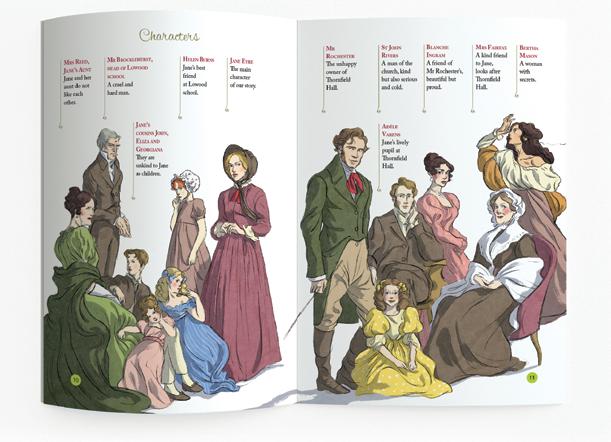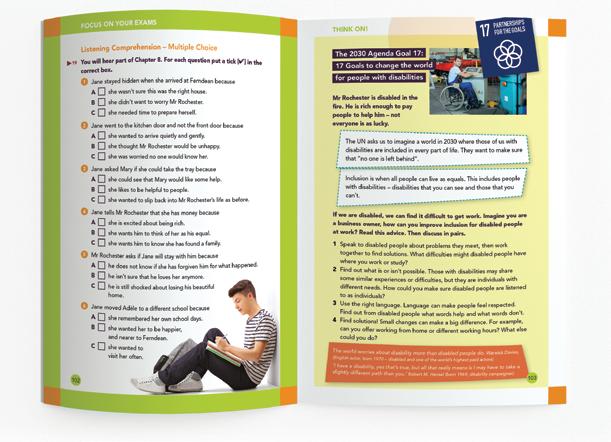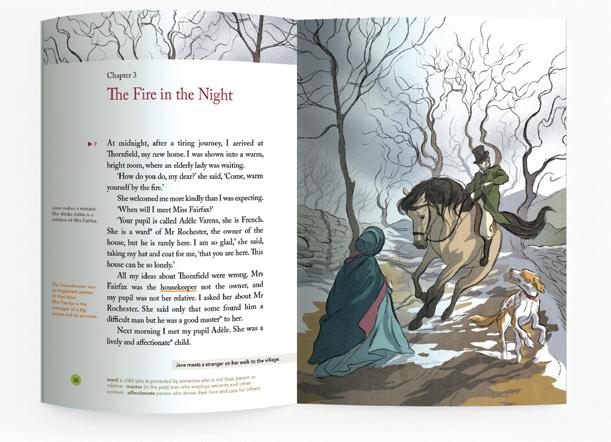Charlotte Brontë Jane Eyre
eliGreenwich
Retold
by Elizabeth Ferretti Illustrated by Giacomo Agnello Modica
Costituzione e Cittadinanza
Sir Arthur Conan Doyle The Sign of the Four
E. Gaskell, K. Chopin, K. Mansfield, V. Woolf, E.Wharton Portraits of Women
Robert
Louis Stevenson The Strange Case of Dr Jekyll and Mr Hyde
Geoffrey Chaucer The Canterbury Tales
Jane Austen Pride and Prejudice
Lewis Carroll Alice in Wonderland
Oscar Wilde The Canterville Ghost
H.G. Wells, G. Orwell, E.A. Poe, S.O. Jewett, V. Woolf One Planet, One Goal
Mary Shelley Frankenstein
George Orwell Animal Farm
K. Mansfield, J. Joyce, O. Wilde, R. Tagore, M. Twain Tales of Friendship
Charlotte Brontë Jane Eyre
Oscar Wilde The Picture of Dorian Gray
H.G. Wells The Time Machine
Printed
Series Editors Paola Accattoli, Grazia Ancillani
Art Director Daniele Garbuglia
Graphic Design Emilia Coari
Production Manager Francesco Capitano
Photo Credits Shutterstock, Alamy
© 2023 ELi, Gruppo editoriale ELi
22.83.264.0
ENG013-01
ISBN 978-88-536-3977-6
www.gruppoeli.it
in Italy
Printing Division, Loreto-Trevi
by Tecnostampa - Pigini Group
INVALSI Esame di Stato Glossario Drama 21st Century Skills Agenda 2030
Legenda
FCE
– Life and Loves
Characters
Pre-reading Activities
Leave Gateshead
Activities
Life at Lowood School
Activities
Fire in the Night
Activities
Eyre on Location
Stranger from Jamaica
Activities
to Gateshead
Activities
Terrible Secret
Activities
no
of Jane Eyre
A Voice in the Night 90 Activities
Chapter
The Figure on the Roof 100 Activities 104 Final Test 110 Drama 112 My Book Contents
6 Dossier 1 Charlotte Brontë
10
12
16 Chapter 1 I
22
26 Chapter 2 My
32
36 Chapter 3 The
42
46 Dossier 2 Jane
50 Chapter 4 A
56
60 Chapter 5 I Return
66
70 Chapter 6 A
76
80 Dossier 3 “I am
bird” – The Power
84 Chapter 7
94
8
Charlotte Brontë: Life and Loves
Quick facts
Name: Charlotte Brontë
Born: Thornton, Yorkshire, England on 21 April 1816
Died: Haworth on 31 March 1855 (aged 38)
Education: Clergy Daughters' School at Cowan Bridge, Lancashire
Key works: Poems by Currer, Ellis, and Acton Bell (1846), Jane Eyre (1847), Shirley (1849), Villette (1853)
Charlotte is Born
Charlotte Brontë is one of the greatest writers in the English language. She was born on 21 April 1816, in Haworth, a town in Yorkshire, in the north of England. But we need to go back in time to understand her better.


6 Dossier
Today Haworth is a quiet village, but in Charlotte‘s time it was busy, and full of new businesses. These used water power to make cloth for clothes.
Haworth village centre.
Patrick Brunty
Charlotte’s father, Patrick, came from a poor family in Ireland, so how did he come to be in England? He became friends with a local vicar – a man who worked for the Christian church – who saw how intelligent he was. Through this friend, Patrick won a prize to study at Cambridge University –this university was mainly for the sons of rich families at the time.
Patrick did well at university, where he studied Greek, Latin and the Bible.
From Brunty to Brontë
At Cambridge, Patrick changed his name to Brontë – this helped him to hide his poor beginnings. Patrick trained to work for the church and in 1820 arrived in Haworth to look after the church and its people. In late 1812 he had married Maria Branwell. They had six children, but life was cruel in those days before modern medicine. Maria died a year later in 1821, when Charlotte was only five.

A New Little Mother
The oldest child, called Maria, became a second mother to her brother and four sisters, then Patrick sent Maria, Elizabeth, Charlotte and Emily away to school. It is likely this school was similar to the one described in Jane Eyre.

Patrick
Jane Eyre is written like an autobiography – the story a person writes about their own life – but it would be wrong to see this as Charlotte’s autobiography. It is above all a story invented by Charlotte the writer.
7
The Brontë sisters never visited Ireland or met their Irish family.
became a vicar in the Christian church. The money he was paid for this job gave him and his family a comfortable life.
Charlotte Brontë’s parents.
The Brontë Sisters (left to right Anne, Emily, Charlotte) by Patrick Branwell Brontë.
Charlotte‘s experiences as a teacher, in a rich family (a governess) gave her a lot to write about in Jane Eyre.
More Sadness Arrives
Maria and Elizabeth became ill with tuberculosis and died in 1825. Charlotte was ten when her sisters died – this was a difficult time for her. We can understand something of how she felt in what happens to Jane Eyre. After that, Patrick brought Charlotte and Emily back to live at home. Charlotte always believed her sisters died because life at that school was so bad.
Tuberculosis is a serious illness. It killed millions at that time, especially the poor.
Little Writers
Charlotte Goes Away
When Charlotte was 19, in 1835, she started work as a teacher, then moved to a house called Stone Gappe, where she taught the children of a rich family. She wrote to her best friend, Ellen Nussey, that she did not enjoy the work at all.
Four letters that Charlotte wrote to Héger still exist. These are kept in the British Library. They show how hopeless Charlotte felt.
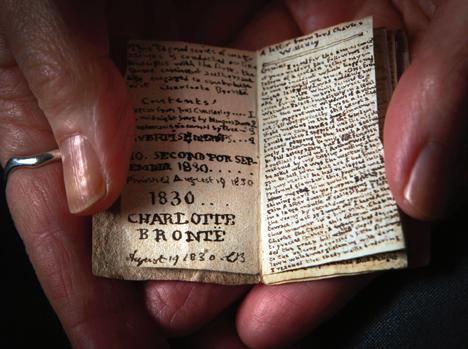
Charlotte, Emily, their brother Branwell, and youngest sister Anne, had a happier time when their aunt, Elizabeth Branwell, looked after them. They had freedom to study and read. All four wrote funny and exciting stories in little books that they made. You can still see these tiny books in their house at Haworth, which is now a museum.
You can find out more about the museum at bronte.org.uk The house is called a Parsonage – this is the name given to the house of a vicar.

Emily and Charlotte Leave England
In 1842, Emily and Charlotte went to school in Brussels to improve their French. There Charlotte fell deeply in love with Constantin Héger who owned the school but was already married. We may understand how strong Charlotte’s feelings were for him when we read Jane Eyre.
8
Brontë Parsonage Museum: historic house where the Brontë family lived.
A tiny book in Brontë Parsonage Museum.
Constantin Héger

Currer, Ellis and Acton Bell
Charlotte and her sister continued to write. Charlotte sent some of her work to a writer, Robert Southey. He replied it was not the job of women to write. This gave Charlotte an idea – the three sisters could sign their work as Currer (Charlotte), Ellis (Emily), and Acton (Anne) Bell. These men’s names would hide the fact that they were women writers.

In early nineteenth century England, writing was not seen as the right thing for women to do, especially if they were from ‘good’ families.
Success at Last
In 1847, the three Brontë sisters were all published. Emily with Wuthering Heights, Anne with Agnes Grey, but Charlotte’s Jane Eyre was the biggest success.
A Terrible Time
Branwell also wanted to be a writer and a painter, but was not successful. He was often depressed, then he got tuberculosis in 1848. He died in September, aged 31. Sadly, he passed on tuberculosis to Emily and Anne and both died soon after. Emily was 31 and Anne 29 years old.
Charlotte Becomes a Wife
Branwell gave us the most famous painting of his sisters. You can see this at the National Portrait Gallery in London. He originally included himself, but later painted over his face.
Charlotte married Arthur Bell Nicholls, who worked with her father. Charlotte was famous by then, and was making money from her writing, but she died in 1855 aged 38. She is buried in the churchyard at Haworth.
Charlotte’s publisher –who made and sold her book – was Smith, Elder and Co. from London. Jane Eyre was their first big success.
9
The first edition of Jane Eyre.
In their famous books, the Brontë sister explored strong feelings, subjects and events that were shocking for women to write or even talk about at the time.
Mrs reed, Jane’s aunt Jane and her aunt do not like each other.
Characters
Mr BrockleHurst, Head of lowood
scHool
A cruel and hard man.
Helen Burns
Jane’s best friend at Lowood school.
Jane eyre

The main character of our story.
Jane’s cousins JoHn, eliza and GeorGiana
They are unkind to Jane as children.
Mr rocHester

The unhappy owner of Thornfield Hall.
st JoHn riVers
A man of the church, kind but also serious and cold.
BlancHe inGraM
A friend of Mr Rochester’s, beautiful but proud.
Mrs fairfax
A kind friend to Jane, looks after Thornfield Hall.
BertHa Mason
A woman with secrets.
adèle Varens Jane’s lively pupil at Thornfield Hall.
Reading Comprehension – True or False
1 Jane Eyre was written in 1847, but talks about an earlier time (probably 1808–1832). Decide if the following are true or false about life in the early nineteenth century.
1 Rich people in England were starting to use electricity in their houses.
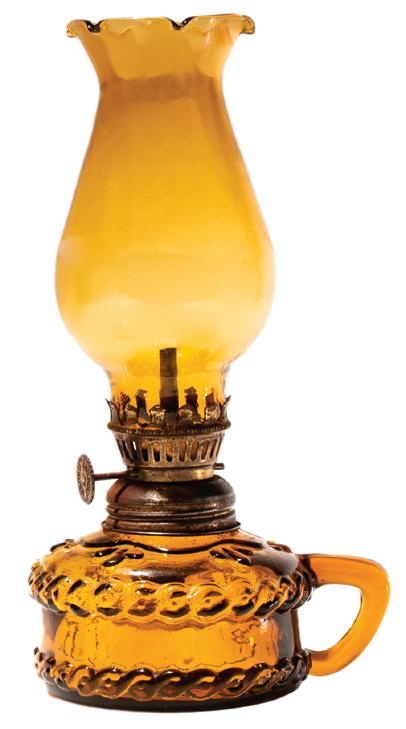
2 Houses were warm, with chimneys and open fires.
3 Windows were large, and let in a lot of light.
4 The rich employed people (called servants) to make their food and clean their houses.
5 Furniture and curtains were made from natural things; there was no plastic.
6 Only poor people used candles.
7 Nobody was interested in fashion.
8 Rich women had a special servant to dress them and make their hair beautiful.
9 Rich women had freedom to make their own decisions.
10 Rich men and boys had more power than the women and girls in their families.
Critical Thinking
2 Check your answers to 1 above, then answer the following questions. Discuss in pairs.
a If you travelled back to 1810, what would you find most strange or difficult about life at that time?
b What might you enjoy?
12 PRE-READING ACTIVITIES
T F
Vocabulary – Gap Fill
3 We meet Jane Eyre as a child of ten. Use the words and phrases in the box to fill in the gaps, and get to know her.
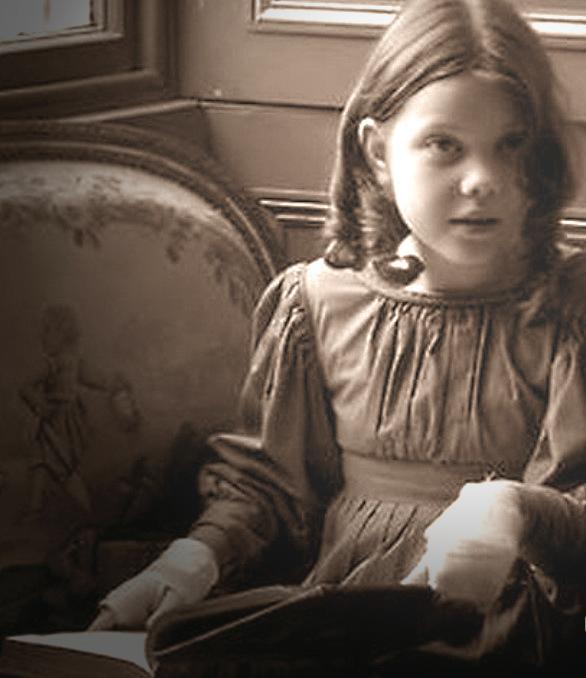
cold – tears – did not like me –dislike – screamed – everyone –horrible – sad heart – protect – scared
1 I did not like coming back to the house after a walk, with hands and a .
2 My aunt , and I did not like her.
3 My cousin John was a boy of fourteen. I was afraid of him. I was only ten and had no one to me.
4 I was and alone. ‘Let me out!’ I , trying to open the door.
5 ‘I am not ill,’ I said, but I could not stop my .
6 ‘I you more than anyone on this earth. […] I will tell what a terrible, unkind aunt you are.’
Vocabulary – Writing
4 What do we learn about Jane Eyre? Give examples from the sentences above. The first has been done for you.
She is unhappy. (1, 5)
13
Jane Eyre (Television mini-series, 2006).
a b c d
Vocabulary – Gap Fill and Match
5 In this chapter you may see words you do not know. Use the sentences below to match each word with its definition.
1 (adj.) very bad
2 _________________ person employed by a rich family to work in their house
3 small lamp with candle inside, has a handle and glass windows
4 person with knowledge of medicine
5 family
6 _________________ large room in a house, for meeting and entertaining guests
7 _________________ person who says things that are not true
8 _________________ feeling of being free
9 _________________ tell someone they have done something wrong, and you are angry about it
10 _________________ (at that time) child with one or both parents not living
a My only relatives were my aunt and my three cousins.
b ‘That is not true,’ I said, ‘you are a liar.’
c I want the power to make my own decisions, I like my freedom.
d It was getting cold, so I told the servants to light the fire for me.
e It was dark, so I lit a lantern to take outside.
f ‘You are a horrible and wicked boy,’ I said.
g I was living with my aunt because I was an orphan.
h When our friends arrived, we took them into the drawing room
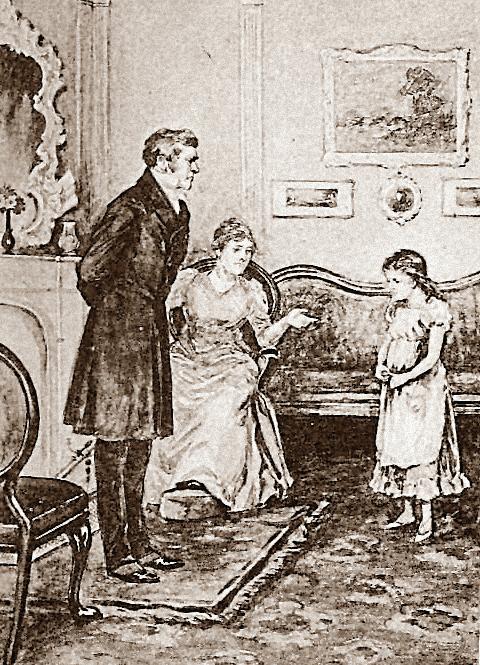
i I was ill, so my mother called the pharmacist to ask his advice.
j Whenever I was rude to my aunt, she told me off.
14 FINAL TEST PRE-READING ACTIVITIES






